Ateliers of Polish painters in Munich ca. 1890
Mediathek Sorted
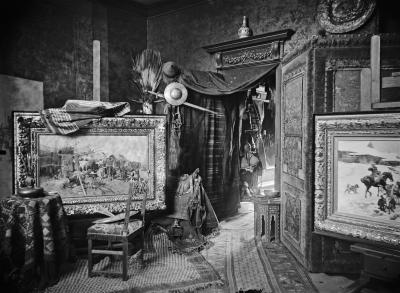
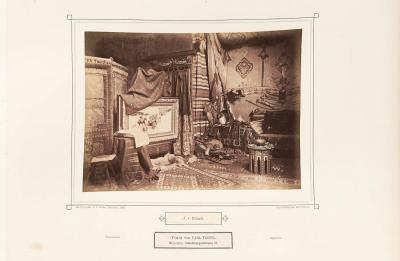

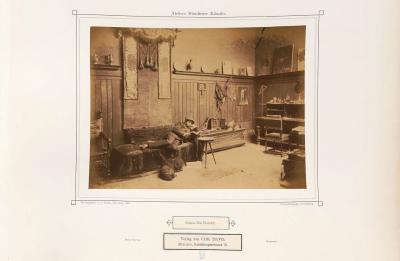






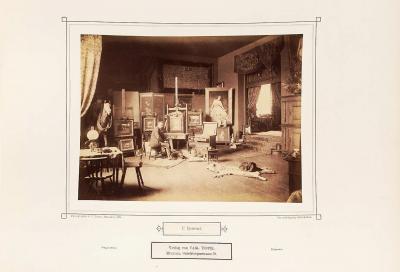




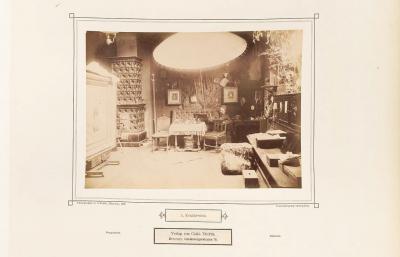


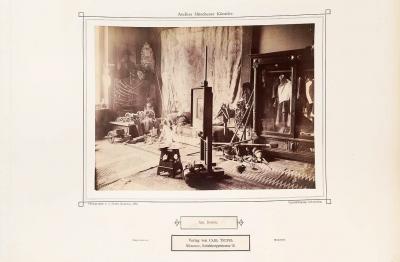



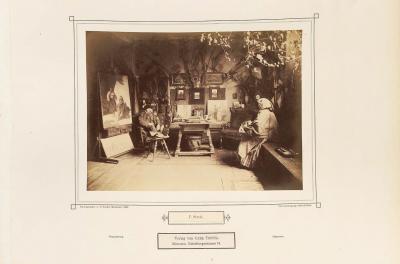

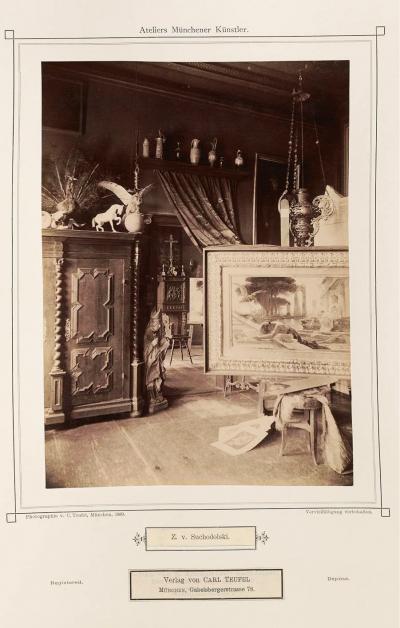

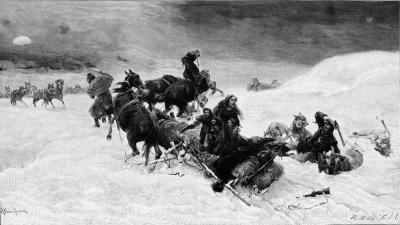


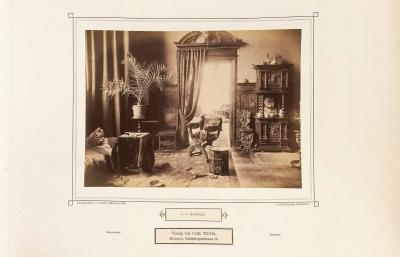



In the years prior to that, Brandt had collected a large number of antiques and requisites on his travels through Poland and the Ukraine, which he used as models for his painting. He also acquired such objects from other artists or from noble families in Poland who had fallen on hard times, sometimes paying for them with paintings.[30] Over time, then, he had put together an extensive collection of sabres and pistols from the Polish hussars, armour, helmets, shields, horse saddles and ‑harnesses, musical instruments and costumes with the figures that belonged to them, antique curtains and fabrics, oriental seating and tables, Turkish tents, Persian carpets and Renaissance and Baroque furniture. His new atelier in Schwanthalerstraße did not just present Brandt with the option to store these objects, he also used them to furnish and decorate his atelier prestigiously. On one side of the corridor he created two atelier rooms, the larger of which he furnished with oriental sofas, a table with inlay work, furniture from the 16th and 17th century, weapons and armour. He covered the walls with a Turkish tent, on the floor he draped Persian rugs. Easels and shelves for paints and brushes served as utensils for his painting. In the second room, he stored suits of armour and musical instruments. It is here that his friend the painter Władysław Szerner (1836-1915) worked for many years, and was also employed by Brandt as a curator for the collection.[31] On the opposite side of the corridor, he set up a storeroom for costumes, pictures and books and an arsenal of historical weapons, suits of armour, regimental banners and Turkish tents, all beautifully organised.
Soon after its opening, Brandt’s atelier was to cause a sensation, not just in Munich but in Poland as well. Obviously based on photographs, Szerner drew an aspect in which Brandt is sitting with a palette at the foot of an elaborately framed painting, which is standing on the easel, and is leafing through an illustrated book. The room was decorated with antlers, weapons, historic materials, wall hanging and draperies, statues, caddies and his own paintings. The interior aspect, that already contains all the elements of the photographs that were created about fifteen years later by Teufel, was published in the Warsaw magazine Kłosy [in English, Ears] in June 1876 as a wood engraving.[32] In October, the Polish author Józef Ignacy Kraszewski (1812-1887), who was based in Dresden, gave a detailed report in his “letters from Munich“ about Brandt’s atelier, which is “truly a historical museum”, “jest to całe muzeum historyczne”.[33] In the December, two aspects of the atelier, on a sheet signed in turn by Szerner, were published on a double page in the Warsaw magazine Tygodnik Ilustrowany [in English, Illustrated Weekly].[34] In these pictures, a second room can also be seen with draperies, an artistically decorated collection of sabres, suits of armour and regimental flags, which is crowned by a picture of the black Madonna and which inspired Szerner to create an even more extensive and decoratively adorned frame for his aspect of the atelier rooms, which was engraved in wood and gave the impression of a peep-box.[35]
The two photographs taken by Teufel in 1889, one of which appears in his book (Fig. 1, 2), show that the basic layout has not changed much in the past fifteen years. However, the collection is now grouped more closely, and carved lintels and screens, ornamental plates and numerous oriental rugs have been added. These images also appeared in Polish magazines in 1890 and 1899.[36] In 1903, the Polish painter and art critic Władysław Wankie (1860-1925), who from 1882 was part of the Munich circle around Brandt for twenty years, reported in the magazine Życie i Sztuka [Life and Art],[37] which was published in St. Petersburg, that even in Poland only a few people would have such an abundance of historical objects as Brandt, “mało kto i w kraju posiada taką całość naszych zabytków”.[38] The most extensive description of the atelier apartment in Schwanthalerstraße comes from one of Brandt’s grandsons, who, at the age of nine visited Brandt, in 1915 when he was dying, and later wrote about it.[39] In 1920, and in accordance with Brandt’s will, all of the in excess of 330 objects which constituted the furnishing of the atelier were transported to Warsaw and given to the National Museum.[40]
[30] Bagińska 2015 (see literature), page 41
[31] Bagińska 2015, page 44
[32] Władysław Szerner (1836-1915): Józef Brandt w swojéj pracowni (Jósef Brandt in his atelier), 1875/76. Holzstich von Jan Styfi (1841-1921), in: Kłosy, 1876, vol. XXII, No. 574, page 405 (online resource: http://www.wbc.poznan.pl/dlibra/publication?id=117872&tab=3); pictured in the online exhibition “Józef Brandt” in this portal, https://www.porta-polonica.de/de/atlas-der-erinnerungsorte/jozef-brandt, Fig. 2
[33] Listy J. I. Kraszewskiego. Monachium w Październiku 1876 r., in: Kłosy, 1876, vol. XXIII, No. 591, page 274, third column (online resource: http://www.wbc.poznan.pl/dlibra/publication?id=117872&tab=3)
[34] J. Wojciechowski: Józef Brandt, in: Tygodnik Illustrowany, 1876, vol. II, No. 52, page 412-414; Władysław Szerner (1836-1915): Pracownia Józefa Brandta w Monachium (The atelier of Jósef Brandt in Munich), 1875/76. Wood engraving by Paweł Boczkowski (1860-1905), page 416 f. (online resource: http://bcul.lib.uni.lodz.pl/dlibra/publication?id=1571&tab=3); pictured in the online exhibition Józef Brandt in this portal, https://www.porta-polonica.de/de/atlas-der-erinnerungsorte/jozef-brandt, Fig. 3
[35] A draft of the adorned frame can be found in the Jacek-Malczewski-Museum in Radom/Muzeum im. Jacka Malczewskiego w Radomiu, as well as the photographs on which the drawing was based. One of the photographs is depicted in Bagińska 2015, page 48, cf note 23 there, another in the same exhibition catalogue, page 56.
[36] S. Fabijański: Pracownia Józefa Brandta, in: Świat 1890, page 517; Pracownia profesora Józefa Brandta w Monachium, in: Tygodnik Ilustrowany, 1899, vol. II, No. 40, page 789 (online resource: http://bcul.lib.uni.lodz.pl/dlibra/publication?id=1491&tab=3)
[37] Władysław Wankie: U Józefa Brandta w Monachium, in: Życie i Sztuka, 1903, No. 48, page 2
[38] Zitiert nach Bagińska 2015, page 46
[39] Andrzej Daszewski (1906-1992): Zbiory militariów Józefa Brandta, in: Muzealnictwo Wojskowe, Warsaw 1985, page 68-76. Photographs of the atelier from 1915 are owned by the Jacek Malczewski Museum in Radom/Muzeum im. Jacka Malczewskiego w Radomiu; depicted in Bagińska 2015, page 47. For the Daszewski’s ancestry, see http://www.sejm-wielki.pl/b/zi.4.7.b
[40] Bagińska 2015, page 48. Today, the collection is housed in different departments at the National Museum in Warsaw/Muzeum Narodowe w Warszawie and at thePolish Army Museum/Muzeum Wojska Polskiego.























































































